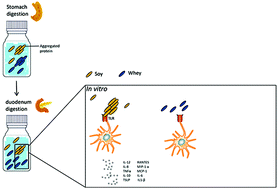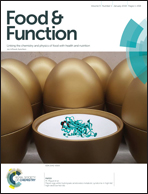Immunomodulating protein aggregates in soy and whey hydrolysates and their resistance to digestion in an in vitro infant gastrointestinal model: new insights in the mechanism of immunomodulatory hydrolysates
Abstract
Hydrolysates, which are used in hypoallergenic infant formulas, have been found to possess immune modulating effects. For an optimal utilization of hydrolysates, the working mechanisms and responsible proteins underlying the effects should be elucidated. In this study, the immunomodulating activity of whey and soy hydrolysates was studied by quantifying TLR activation and assessing cytokine production in hydrolysate stimulated dendritic cells. The responsible protein fraction was identified and characterized by gel electrophoresis. The immune effects under gastrointestinal conditions were studied by digesting the hydrolysates in an in vitro infant digestion model, after which the digests were analyzed. In both soy and whey hydrolysates, TLR activation and cytokine production in dendritic cells were induced by a fraction containing protein aggregates larger than 1000 kDa, which were formed by electrostatic interactions and disulfide bonds. Only soy aggregates remained intact during duodenal digestion, and maintained the TLR activating capacity. Soy and whey protein aggregates larger than 1000 kDa possess immunomodulatory properties, but only soy aggregates remain under intestinal digestion conditions. This knowledge is important for a better understanding of the effects of hydrolysates.



 Please wait while we load your content...
Please wait while we load your content...